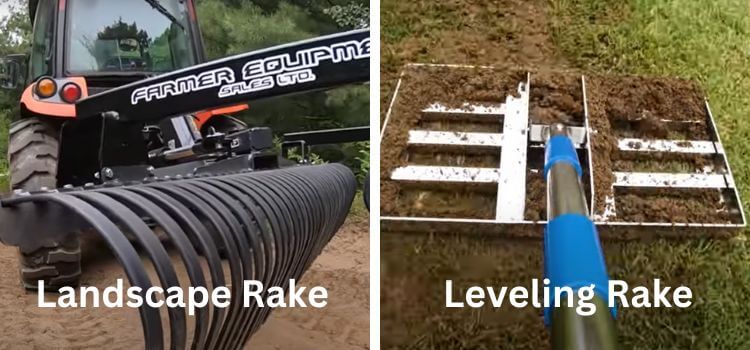As an Amazon Associate, I earn from qualifying purchases.
Keeping your lawn or garden neat and healthy can feel like a big task, especially if you don’t have the right tools. Two rakes that gardeners often compare are the Landscape Rake 36 Inch Head by RUIJIU and the Lawn Leveling Rake 30×10 Inch by Dremmt. Both are highly rated online, but they serve different purposes.
In this article, I’ll help you understand the differences between these two rakes. I’ll cover their features, pros and cons, and which rake works best for different tasks. By the end, you’ll know which rake is the right fit for your lawn or garden.
What is Landscape Rake?
A landscape rake is essential for easy lawn and garden care. Its broad, lightweight head and long handle make spreading soil, removing leaves, and clearing debris simple. For the best results, consider the RUIJIU 36 Inch Head Landscape Rake. Below are its features, pros, and a detailed review.
RUIJIU Landscape Rake 36 Inch Head
The RUIJIU Landscape Rake is a versatile, lightweight tool for easy garden and lawn care. Its 36-inch broad aluminum head covers large areas quickly, while the 67-inch handle makes it comfortable to use for extended periods. Ideal for spreading soil, leveling gravel, removing leaves, and clearing debris from gardens, ponds, or beaches.
Why You Will Love This
- Lightweight and easy to handle for long periods
- Broad head covers large areas quickly
- Detachable rods make assembly simple
- Comes with cut-resistant gloves for safety
- Rust-resistant aluminum lasts for years
Pros
- Easy to maneuver, even for beginners
- Multi-purpose: soil, leaves, pond debris
- Affordable and practical
- Helps save time on large areas
Cons
- Tines may bend on heavy soil or roots
- The rubber handle cap can slip without glue
I used this rake to clean leaves and smooth soil in my small garden. Its lightweight design made it easy to work for a long time without getting tired. For heavier soil, go slowly to prevent bending the tines.
What is Lawn Leveling Rake?
A lawn leveling rake is a heavy-duty gardening tool designed to create smooth, even surfaces on lawns and gardens. It helps spread soil, sand, or fertilizer efficiently, making yard maintenance easier and more precise. For the best results, consider the RUIJIU 36 Inch Head Landscape Rake. Below are its features, pros, and a detailed review.
Dremmt Lawn Leveling Rake 30×10 Inch
The Dremmt Lawn Leveling Rake is a heavy-duty, professional-grade tool designed to help you achieve a smooth, even lawn. Its 30×10-inch stainless steel head is strong enough to handle soil, sand, and fertilizer, while the 72-inch ergonomic handle makes it comfortable to use for longer sessions. Perfect for large yards, gardens, and landscaping projects.
Why You Will Love This
- Heavy-duty construction for long-lasting use
- Weighted head helps naturally level high and low spots
- Covers large areas quickly, saving time and effort
- Comes with gloves and lawn shears for added convenience
Pros
- Durable stainless steel head
- Efficient for soil leveling and topdressing
- Ergonomic handle reduces hand fatigue
- Suitable for professional and home use
Cons
- Heavier to handle for beginners
- Takes more storage space
I used this rake to spread topsoil on a backyard lawn. The weight helped smooth high spots, and I finished the entire area faster than with a regular rake. Beginners may feel the weight at first, but it becomes easier with practice.
Quick Comparison: Landscape Rake vs Lawn Leveling Rake
| Feature | Landscape Rake | Lawn Leveling Rake |
|---|---|---|
| Head | 36 in | 30×10 in (other sizes available) |
| Handle | 67 in | 72 in, ergonomic |
| Material | Aluminum | Stainless steel |
| Weight | 1.84 kg | 4.65 kg |
| Accessories | Gloves | Gloves + shears |
| Best Use | Light soil, leaves | Leveling soil, sand |
Who Should Buy Which Product?
Landscape Rake (RUIJIU) is best for:
- Small to medium lawns or gardens
- Leaf cleanup, pond debris, and light soil work
- Budget-conscious gardeners
- Anyone who prefers a lightweight, easy-to-use rake
Lawn Leveling Rake (Dremmt) is best for:
- Large yards or landscaping projects
- Heavy soil leveling and topdressing
- Professional landscapers or serious DIYers
- People who don’t mind a heavier, more durable rake
FAQ About Landscape Rake vs Leveling Rake
1. Can the Landscape Rake handle heavy soil?
It can, but tines may bend if used too aggressively. Work slowly or tackle smaller sections.
2. Is the Lawn Leveling Rake beginner-friendly?
Yes, but its weight may feel challenging at first. Start with a small area.
3. Can either rake handle mulch or gravel?
Both handle light mulch and gravel. For heavier materials, the Dremmt rake is better.
4. Are the handles adjustable?
No, neither rake has adjustable handles, but the Landscape Rake is detachable for storage.
5. Which rake is better for leaves?
The lightweight RUIJIU Landscape Rake is more straightforward to maneuver for leaf cleanup.
Conclusion
The RUIJIU Landscape Rake is perfect for small to medium yards, leaf cleanup, and light garden tasks. The Dremmt Lawn Leveling Rake is better for heavy soil leveling and large landscaping projects. Both are durable and useful, depending on your needs. For everyday garden work, go with the lightweight rake; for big leveling jobs, the weighted rake works best.



